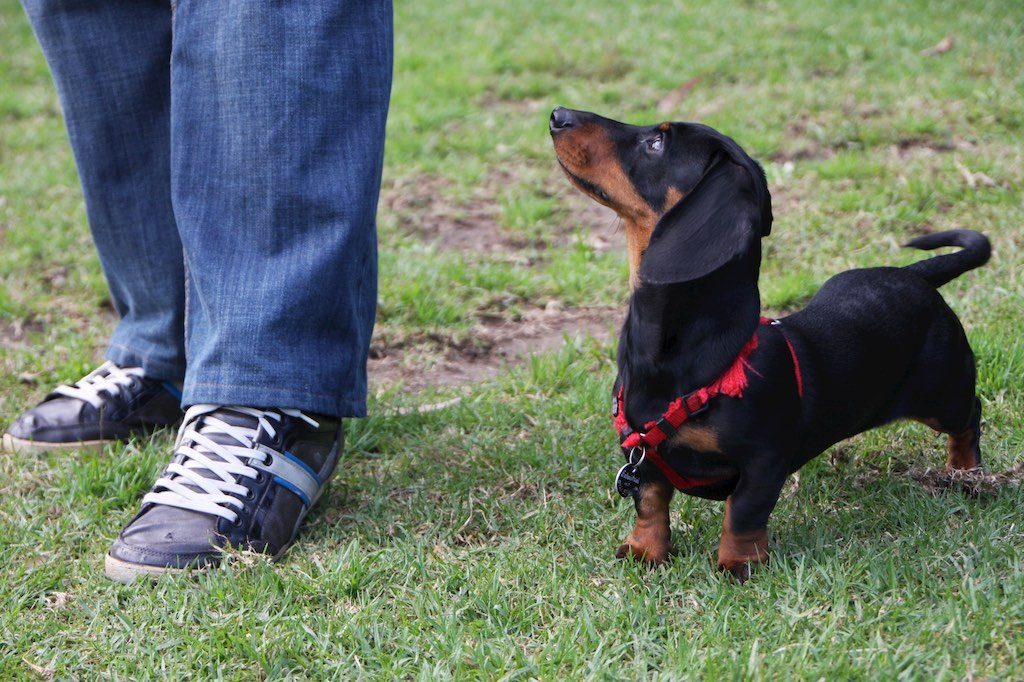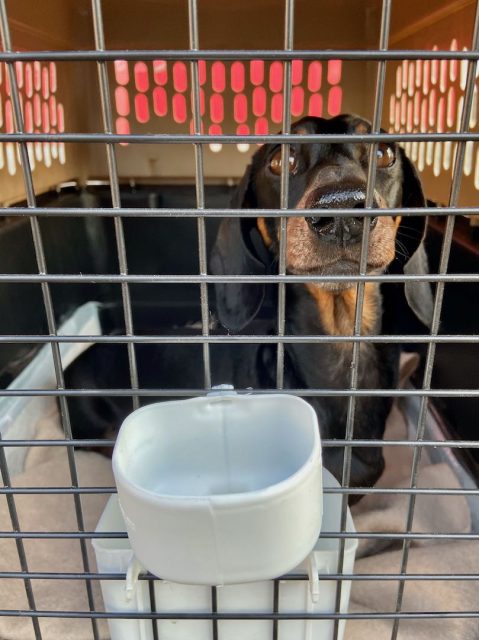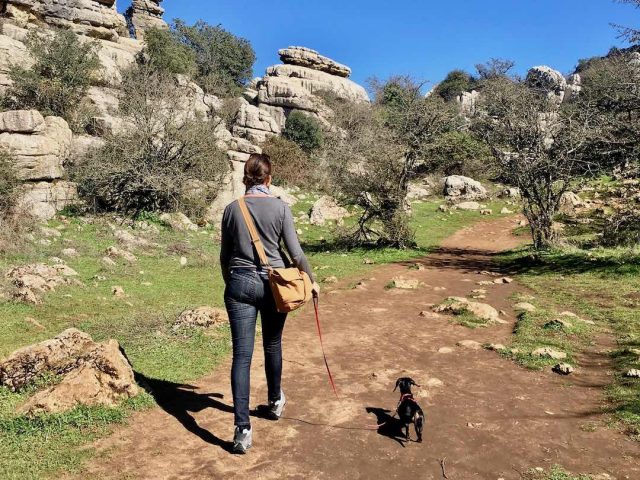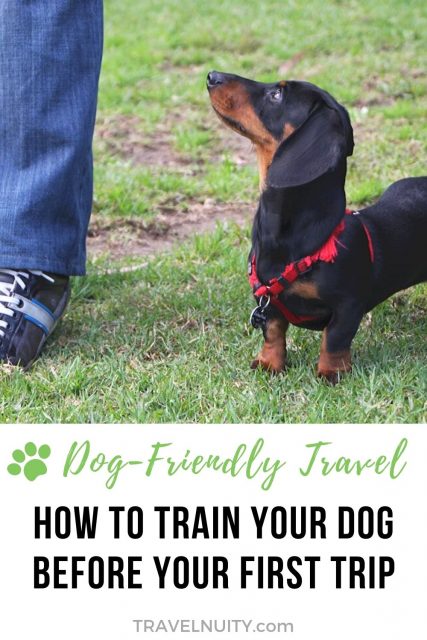Before travelling together with your dog, you should consider whether your dog would benefit from training. Like many dog owners, I took my dog to puppy classes when he was young. But like others, we didn’t keep up his lessons, and bad habits can creep in over time.
When travelling with a dog, your dog will end up being put into more stressful situations than when they are living with you at home. Consider how they will deal with joining you at cafes, being crated while travelling on planes or trains, plus staying in unusual accommodation, such as noisy hotels or in a tent.
Before heading off overseas with Schnitzel, we ended up meeting up with a dog trainer to concentrate on some of the areas we needed to focus on, in particular dining out.
As part of your preparations for holidaying with your dog for the first time, consider these areas for training your dog before travelling together.

1. Crate Train Your Dog
If you’re going to fly with your dog, whether in the cabin or in the hold, or take them onto public transport where they need to travel in a carrier, the process will be a lot smoother and less stressful for everyone if your dog has already been crate trained. Crate training is also handy if you need to leave your dog in a hotel room in their crate, or use it for safety when travelling in a car.
I recommend crate training your dog when they’re just a puppy, and first come home with you. When Schnitzel was a puppy, he slept every night in his crate. (Although he later switched to the bed!) This also ensured that he never had accidents during the night – instead he learnt to bark if he needed to go outside.
He also always travelled in his crate when going in the car, mainly on visits to family, and he came to love going into his crate as soon as he realised a car trip was imminent.

Even if you haven’t crate trained your dog from an early age, it’s possible to start in later life. I recommend starting as soon as possible before an upcoming plane or train trip. Buy their crate as early as possible and introduce them to it. Allow them to sniff it and go inside of it. To encourage them to go inside and make positive associations for them, feed them inside of the crate.
Ideally, when your dog comes to be transported in their crate, they willingly enter it and sit down inside. This will greatly decrease their stress from the journey and experience. Although it always helps to add a favourite blanket or an old t-shirt with your smell on it, to help settle them down. In my experience, once they’re used to one crate, switching to a different crate or carrier is easy.
2. Encourage Your Dog to Bark Less
If your dog already tends to bark, they will likely bark when put in the unusual situations that occur during travel! While it may be impossible to stop them barking completely (and according to some dog trainers, not the best result to aim for, as they often bark for a reason to protect you), you should look at ways to stop them barking as often.
One common technique is to reward your dog for stopping barking. Choose a word to say to your dog if they bark, or buy and use a clicker. Upon hearing the command or the clicker, your dog will be distracted and turn their attention to you. Hold their attention and reward them with a small treat if they stay quiet. Gradually lengthen the time before you give your dog the treat.
The main technique that I’ve relied on (partially as Schnitzel hasn’t responded well to the above method) is to consider what environments my dog is likely to bark in and avoid those when possible. For instance, Schnitzel tends to bark if we stay in noisy rooms, where you can hear a lot of external noise.
Thus, when choosing an Airbnb apartment, I’ve tended to avoid places where people complain about street noise. At hotels, I’ve often asked for a quieter room, ideally not the room directly outside of the lift.
Dogs also often barked when they are bored, such as if you are sitting outside at a cafe and they don’t understand why you’re just sitting and talking, not paying attention to them, especially if you also start to eat! A distracting chew treat or toy may be useful, to help keep them occupied and happy.
3. Train Your Dog To Bathroom on Command
When you’re out and about with your dog in foreign places, it helps to have your dog trained to go to the bathroom on command. This is helpful in so many situations, from rest breaks on a long road trip to when you’re about to take a flight to just before heading to bed while staying in a high-rise hotel.
If you used a certain word with your dog while toilet training them as a puppy, start to use that word again. Expect them to go to the bathroom when you say the word (perhaps repeat it a few times), and then reward them with a treat, until they are in the habit of going on command.
The trickiest part is getting your dog to toilet in strange situations or on unusual surfaces. Many dogs, including often Schnitzel, will only go on grass. We sometimes took him on quite a walk while staying in Italian city centres full of cobblestone streets.

It’s also for this reason I put together this guide to dog-friendly airports in Europe, where proper pet relief areas are very rare. In the guide, read about the troubles of getting him to bathroom at CDG Airport before our long flight to New York!
An extra helpful step is to get your dog to toilet on a puppy pee pad on command. We haven’t done this with Schnitzel, as he has never previously used puppy pee pads and he has rarely been in situations where this would be useful. Some people recommend puppy pee pads for longer flights, although it’s tricky given how tiny plane bathrooms area.
If your dog does refuse to go, keep in mind that older dogs (not puppies) can often hold on for longer than you expect. Most dogs on flights tend to hold on fine for the duration, without using a puppy pee pad.
4. Teach Your Dog to Return When Called
If you plan to allow your dog off a leash when travelling, it is essential they have been trained to return to you when called. This is particularly true if you are in a foreign place, with more distractions than at home and they have no idea of where “home” is if they run off.
Practice recall with your dog, firstly in a quiet, familiar place, perhaps in your own backyard or inside your home. Reward them when they come when called, usually with a treat, or perhaps with cuddles and attention. Gradual step up the difficulty level, by practising recall in more distracting environments. However, always set up your dog for success, and don’t challenge too much during training.

If your dog isn’t the best at recall (some dogs are more difficult to train than others), then keep them on a leash when out and about with them. Note that many places will have rules requiring your dog to be on a leash, or only let off a leash if they are under your effective control.
If you want to let your dog to roam further afield on a walk, consider getting a retractable leash, but always be careful with this type of leash.
5. Familiarise Your Dog with a Muzzle
If you plan to travel in Europe with your dog, in particularly a larger dog, there are some countries where you dog will be expected to wear a muzzle. In some countries this will apply in all public places, while other countries it just applies on public transport, with varying degrees of enforcement. Check out my guide to dogs and muzzles in Europe to determine if you will likely be affected.
Most dogs are not familiar with wearing a muzzle, and can react badly to them, not surprisingly! Buy a muzzle well before your trip and familiarise your dog with it, ideally following one of the muzzle training courses. See my guide for more information.
You May Also Like
- How to Travel with Your Dog For the First Time
- 9 Tips for Travelling with a Puppy
- 6 Things to Organise Before Travelling with Your Pet
About the Author

Shandos Cleaver is the founder of Travelnuity: Dog-Friendly Travel. She has travelled extensively with her Miniature Dachshund, Schnitzel, including to 33 countries across Europe, every state and territory of Australia except Tasmania, and 10 of the United States. She’s passionate about providing inspiration and information to others wanting to travel with their dogs, whether close to home or internationally.
Inspired? Pin this to your Pinterest board!


Well, this tips works a lot as it is well-said that dog should be trained properly, as before taken to the unknown place. As from my view it is more convenient to take a dog trainer along with you as they better know to deal with any condition in a surplus situation too.
That’s a great idea to have a dog trainer with you at unusual places, rather than just in the more familiar place of home.
Wow. Great idea. Do you provide them with their own hotel room, or do they share with your hair stylist and valet?
Now that would be the life!
I enjoyed reading this article because you explained how you should reward your dog when they come after you call them. My daughter and her fiance adopted a puppy recently and they are thinking about training him in obedience. They are very good at finding services in their area, so I am not worried about them finding the right training for their new puppy.
That’s great to hear!